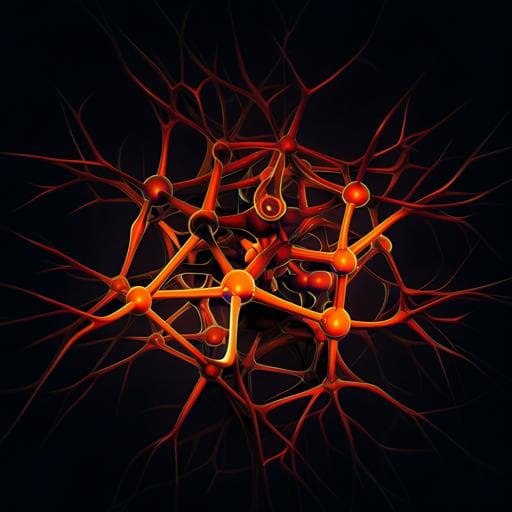
Psychology
Patterns of brain asymmetry associated with polygenic risks for autism and schizophrenia implicate language and executive functions but not brain masculinization
Z. Sha, D. Schijven, et al.
This study by Zhiqiang Sha, Dick Schijven, and Clyde Francks explores the intriguing links between polygenic risk scores for autism spectrum disorder and schizophrenia with brain asymmetries in over 32,000 UK Biobank participants. The findings reveal unique brain asymmetry patterns tied to each disorder, highlighting the roles of language and executive functions.
~3 min • Beginner • English
Introduction
The study investigates whether polygenic risks for autism spectrum disorder (ASD) and schizophrenia are associated with distinct or opposing patterns of structural brain left-right asymmetry, and whether any such patterns resemble average sex differences (i.e., brain masculinization or feminization). Prior theories posit ASD as an “extreme male brain” characterized by over-systemizing and under-empathizing, while schizophrenia positive symptoms have been framed as hyper-mentalizing, suggesting potential opposition along a social cognition dimension. Both disorders show some overlaps (e.g., executive dysfunction, social cognition deficits) and partial genetic sharing, yet largely distinct genetic architectures. Because hemispheric asymmetry is a core organizational principle of brain structure and function, is partly heritable, and differs on average by sex, the authors test multivariate associations between polygenic risk scores (PRS) for ASD and schizophrenia and 42 heritable regional brain asymmetry indices in a large adult population cohort (UK Biobank). They further assess whether PRS-related asymmetry patterns align with sex-based asymmetry, and functionally annotate implicated regions to infer cognitive domains involved.
Literature Review
The paper reviews concepts of ASD and schizophrenia as diametric disorders regarding systemizing/empathizing and mentalizing, alongside known sex differences that fueled hypotheses of brain masculinization in ASD. It summarizes shared features such as executive dysfunction and social cognition impairments but emphasizes largely distinct genetic contributions, with modest common SNP-based genetic correlation (~0.2). Hemispheric asymmetry is described as pervasive in human brain organization, implicated in language, social cognition, executive, and affective processes, and altered in both ASD and schizophrenia across structural and functional measures; asymmetry also shows sex differences and links to prenatal testosterone. Asymmetry likely has prenatal genetic underpinnings and modest heritabilities. Prior work by the authors identified 42 asymmetry indices with significant SNP-based heritability and genetic links to microtubule functions and fetal brain expression, and observed overlap of asymmetry-associated SNPs with ASD and schizophrenia GWAS signals. This motivates examining PRS associations with asymmetry as intermediate phenotypes to parse shared vs. distinct etiologies and the masculinization/feminization hypothesis.
Methodology
Design and cohort: Cross-sectional imaging-genetic analysis in UK Biobank adults (N=32,256; 15,288 male, 16,968 female; age 45–81, mean 63.77). Analyses restricted to White British ancestry. Genetic QC: Used imputed genotypes (March 2018). Exclusions: one per pair with kinship > 0.442; sex mismatch; sex chromosome aneuploidy; high heterozygosity (>0.19 after PCs); genotype missing rate > 0.05. Retained 9,803,522 bi-allelic variants with MAF > 1%, INFO ≥ 0.7, HWE p ≥ 1×10−7.
Neuroimaging: T1-weighted MRI (Siemens Skyra 3T, 32-channel head coil). FreeSurfer 6.0 parcellation into 34 cortical regions per hemisphere (Desikan-Killiany atlas) and segmentation of 7 subcortical structures per hemisphere. Cortical surface area measured at gray–white boundary; thickness as average distance between white and pial surfaces. Temporal pole excluded for unreliability. Outliers >6 SD removed per measure. Asymmetry index (AI) per region: (Left − Right)/((Left + Right)/2). Rank-based inverse normalization applied; linear regression used to remove confounds: age, nonlinear age (age−mean_age)^2 term, first 10 genetic PCs, scanner X/Y/Z position, T1 SNR, T1 CNR, assessment center, genotyping array, and sex. Focused on 42 regional AIs with significant SNP-based heritability (FDR<0.05) from prior work.
Polygenic risk scores: Summary statistics from GWAS of ASD (n=46,350; Grove et al. 2019) and schizophrenia (n=82,315; PGC 2014). PRS computed using PRS-CS (Bayesian regression; autosomes only) with default settings and global shrinkage parameter 0.01, using 1000 Genomes Phase 3 European LD reference. SNP overlap counts: ASD PRS based on 1,092,064 SNPs; schizophrenia PRS on 1,097,357 SNPs. PRS z-scored.
Statistical analyses: Primary test per disorder PRS used canonical correlation analysis (MATLAB canoncorr) between PRS and the 42 AIs, yielding a canonical correlation and AI loadings (correlations between each AI and the canonical AI variable). Post hoc, univariate Pearson correlations between PRS and each unilateral brain region measure (left and right separately), covariate-adjusted as above.
Comparing PRS patterns: Correlated the 42 AI loadings from ASD PRS analysis with the 42 from schizophrenia PRS; empirical p from 10,000 permutations preserving within-subject PRS relation and AI covariance structure while shuffling PRS relative to AIs.
Functional annotation: Identified AIs with |loading|>0.2 for each PRS. Constructed bilateral masks for those regions in MNI152 space. Used Neurosynth decoder (Dec 2020 database: 14,371 studies; 507,891 peaks) to compute brain-wide co-activation maps and correlate with 1,307 term-based meta-analytic maps; reported cognitive/disorder terms with r>0.2 (excluding anatomical/nonspecific/duplicate terms). Correlation sample size was 228,415 voxels.
Sex analyses: Tested PRS differences by sex via two-sample t-tests. Re-ran AI residualization excluding sex as a covariate, then tested sex differences on each AI via t-tests (N=32,256). Correlated the 42 PRS AI loadings with the 42 sex t-values; permutation tests (n=10,000) assessed significance, accounting for AI interdependencies.
Handedness: Self-reported categories from first visit: right-handed (n=28,703), left-handed (n=3,059), mixed (n=490); non-right-handed total n=3,549. Logistic regressions for left vs right, mixed vs right, and non-right vs right, predicting from ASD and schizophrenia PRS with same covariates as main analysis.
Phenome-wide association study (PheWAS): Using PHESANT on 3,238 UK Biobank phenotypes relevant to imaging genetics, across data types (continuous, binary, ordered, unordered categorical) with appropriate regression models; continuous variables inverse-normalized. Adjusted for same confounds including sex. Excluded the specific brain phenotypes used to compute AIs, covariates, and handedness. FDR 0.05 applied separately per PRS.
Brain size adjustment: Tested whether adding total brain volume (gray + white matter) as an additional covariate for AIs altered PRS–AI multivariate associations.
Key Findings
- PRS correlation: ASD and schizophrenia PRS were weakly but significantly positively correlated (r=0.08, p=7.13×10−50; N=32,256).
- Multivariate PRS–asymmetry associations:
• ASD PRS associated with brain asymmetries (canonical r=0.03, p=2.17×10−9).
• Schizophrenia PRS associated with brain asymmetries (canonical r=0.04, p=2.61×10−11).
- Distinct PRS patterns: The 42 AI loadings from ASD and schizophrenia PRS analyses were not significantly correlated (r=−0.03, permuted p=0.87; N=42), indicating largely unrelated multivariate asymmetry patterns across regions.
- Concordant regional finding: Only the pars opercularis surface area AI showed concordant substantial loadings for both PRS (ASD loading −0.30; schizophrenia loading −0.28), indicating reduced leftward asymmetry with higher PRS for both disorders.
- Functional annotation (Neurosynth): Regions with strongest AI loadings for each PRS co-activated with networks linked primarily to language and executive functions.
• ASD PRS mask: 19 terms with r>0.2; top terms included “word” (r=0.37), “phonological” (r=0.36), “language” (r=0.34), “reading” (r=0.33), and executive-related terms “demands” (r=0.30), “working memory” (r=0.24). Term “ASD” also present (r=0.27).
• Schizophrenia PRS mask: 21 terms with r>0.2; similar prominence of language (e.g., “language” r=0.33, “phonological” r=0.31) and executive functions (“demands” r=0.29, “working memory” r=0.27); “ASD” term present (r=0.26).
- Sex relations: Females had slightly higher ASD PRS (t=3.55, p=3.84×10−4) and schizophrenia PRS (t=2.77, p=0.006). Many AIs showed significant sex differences overall, but PRS AI loading patterns did not correlate with sex-based AI differences (ASD: r=−0.22, permuted p=0.16; schizophrenia: r=−0.13, permuted p=0.50), providing no evidence for PRS-related masculinization or feminization of brain asymmetry.
- Handedness: ASD PRS positively associated with non-right-handedness vs right (β=0.05, p=0.004), driven by mixed-handedness vs right (β=0.14, p=0.002), with left-handedness vs right at trend (β=0.04, p=0.05). Schizophrenia PRS showed no handedness associations (p>0.05).
- PheWAS:
• ASD PRS: 4 FDR-significant associations: difficulty following conversation with background noise (β=0.06, adj p=2.7×10−3), higher Townsend deprivation index (β=0.03, adj p=2.75×10−3), higher odds of college/university degree (β=0.05, adj p≤5.55×10−3), long-standing illness/disability/infirmity (β=0.06, adj p=1.53×10−2). Trend toward higher fluid intelligence (β=0.04, uncorrected p=8.78×10−6; not FDR-significant).
• Schizophrenia PRS: 495 FDR-significant associations, notably poorer cognitive performance (e.g., trail making interval: β=0.10, adj p=2.13×10−47; fluid intelligence: β=−0.14, adj p=1.56×10−14), and numerous brain and psychological measures; small number diagnosed with schizophrenia (n=10) nonetheless showed positive association with PRS (β=1.13, adj p=0.0078).
- Brain size: Total brain volume not associated with ASD PRS (β=−0.006, p=0.16) but negatively associated with schizophrenia PRS (β=−0.02, adj p=3.58×10−4). Adjusting AIs for brain size did not materially change the multivariate PRS–AI results (ASD canonical r=0.03, p=2.25×10−9; schizophrenia canonical r=0.04, p=2.57×10−11).
Discussion
The findings demonstrate that polygenic risks for ASD and schizophrenia each associate with subtle but significant multivariate patterns of brain structural asymmetry, yet these patterns are largely distinct and not oppositional. This challenges models positing ASD and schizophrenia as opposing ends of a single neurobiological dimension and suggests largely separate etiologies with some shared features. There was no evidence that PRS-related asymmetry patterns resembled sex-based asymmetry differences, providing no support for brain masculinization or feminization in the etiologies as reflected in structural asymmetry.
Functional annotation implicated language and executive function networks for both disorders, aligning with known behavioral and cognitive features and PheWAS results (e.g., executive deficits with schizophrenia PRS, educational attainment with ASD PRS). The pars opercularis asymmetry emerged as a shared locus, consistent with Broca’s area involvement in language production; reduced leftward asymmetry with higher PRS in both disorders may reflect suboptimal organization in language circuitry and could relate to communication deficits and, for schizophrenia, potentially to mechanisms underlying auditory verbal hallucinations via altered left-lateralized frontotemporal control.
Effect sizes were small, likely due to modest heritability of macrostructural asymmetries and substantial developmental stochasticity. Nonetheless, the results provide biological insights into disorder-relevant brain organization, suggesting that specific asymmetry alterations in language and executive regions may be intermediate manifestations of polygenic liability. Future work leveraging higher-resolution neurobiological measures and longitudinal designs may clarify causal pathways and mediation between genetic risk, asymmetry development, and clinical/behavioral outcomes.
Conclusion
Polygenic risks for ASD and schizophrenia are each associated with distinct multivariate patterns of brain structural asymmetry in a large population sample, with convergent involvement of language and executive function regions but no evidence of overall brain masculinization or feminization. A shared association in pars opercularis asymmetry suggests overlapping etiological features in the language domain. These subtle asymmetry alterations likely represent functionally relevant manifestations of polygenic liability rather than diagnostic biomarkers. Future research should: (1) employ higher-resolution modalities (cellular, synaptic, gene expression) to detect stronger associations; (2) use longitudinal cohorts to elucidate developmental trajectories and causal mediation; (3) improve PRS precision with larger GWAS datasets; and (4) examine connectivity and functional laterality mechanisms linking asymmetry with language and executive dysfunctions across disorders.
Limitations
- Small effect sizes (canonical r ≤ 0.04); significance driven by large sample size.
- Macrostructural asymmetry measures are coarse-grained with low heritability (<10%); substantial variance may reflect early developmental randomness.
- UK Biobank sample is older (mean ~64 years), not matched to typical onset periods; age-related changes may obscure developmental effects, especially for ASD.
- Potential selection bias: UK Biobank under-represents males with high psychiatric polygenic risk; PRS were higher in females, possibly reflecting participation bias.
- Limited diagnostic validation within UK Biobank: very few schizophrenia cases; no comparable ASD diagnosis variable, limiting direct PRS–diagnosis validation.
- PRS index only common variant contributions; ASD PRS may be less accurate due to smaller GWAS compared to schizophrenia.
- Analyses restricted to White British ancestry, limiting generalizability across ancestries.
- Handedness not included as a covariate to avoid collider bias; residual confounding by unmeasured factors remains possible.
Related Publications
Explore these studies to deepen your understanding of the subject.







